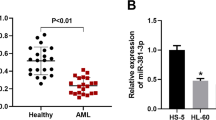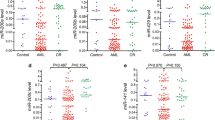Abstract
Purpose
The aim of this study was to investigate roles of microRNA (miR)-183 in pediatric acute myeloid leukemia (AML).
Methods
miR-183 expression in bone marrow and patients’ sera of childhood AML was detected by real-time quantitative PCR. Functions of miR-183 in malignant phenotypes of two leukemia cell lines were then evaluated. Additionally, putative targets of miR-183 were predicted using three miRNA target prediction algorithms and validated by luciferase reporter assay. Clinical relevance of miR-183 and its target gene were further determined.
Results
miR-183 expression in bone marrow and patients’ sera of childhood AML was both significantly higher than those in the corresponding normal controls (both P < 0.001). Enforced expression of miR-183 dramatically enhanced cell proliferation and G1/S transition, but inhibited cell apoptosis of leukemia cells. Bioinformatics prediction and luciferase reporter assay identified programmed cell death 6 (PDCD6) as a direct target gene of miR-183. Moreover, high serum miR-183 combined with low serum PDCD6 mRNA was significantly associated with French–American–British classification subtype M7 (P = 0.01) and unfavorable karyotypes (P = 0.006). Further multivariate analysis identified the combination of serum miR-183 and PDCD6 levels as an independent prognostic factor for both relapse-free and overall survivals. Functionally, re-introduction of PDCD6 markedly reversed the effects of miR-183 in cell cycle, proliferation and apoptosis of two leukemia cell lines.
Conclusion
Combined serum miR-183 and PDCD6 mRNA may serve as a novel prognostic biomarker for pediatric AML. Interestingly, miR-183 may function as an oncogene and may enhance cell proliferation by targeting PDCD6, implying a potential therapeutic target for this malignancy.








Similar content being viewed by others
References
Bai J, Guo A, Hong Z et al (2012) Upregulation of microRNA-100 predicts poor prognosis in patients with pediatric acute myeloid leukemia. Onco Targets Ther 5:213–219
Betel D, Wilson M, Gabow A et al (2008) The microRNA.org resource: targets and expression. Nucleic Acids Res 36(Database issue):D149–D153
Dambal S, Shah M, Mihelich B, Nonn L (2015) The microRNA-183 cluster: the family that plays together stays together. Nucleic Acids Res 43:7173–7188
Danen-van Oorschot AA, Kuipers JE, Arentsen-Peters S et al (2012) Differentially expressed miRNAs in cytogenetic and molecular subtypes of pediatric acute myeloid leukemia. Pediatr Blood Cancer 58:715–721
Dewan K, Agarwal K (2015) Acute lymphoblastic leukemia with normal platelet count. Cancer Transl Med 1:181–182
Dweep H, Gretz N (2015) miRWalk2.0: a comprehensive atlas of microRNA-target interactions. Nat Methods 12:697
Fan D, Wang Y, Qi P et al (2016) MicroRNA-183 functions as the tumor suppressor via inhibiting cellular invasion and metastasis by targeting MMP-9 in cervical cancer. Gynecol Oncol 141:166–174
Forthun RB, Hinrichs C, Dowling TH et al (2016) The past, present and future subclassification of patients with acute myeloid leukemia. Curr Pharm Biotechnol 17:6–19
Garcia DM, Baek D, Shin C et al (2011) Weak seed-pairing stability and high target-site abundance decrease the proficiency of lsy-6 and other microRNAs. Nat Struct Mol Biol 18:1139–1146
Gu W, Gao T, Shen J et al (2014) MicroRNA-183 inhibits apoptosis and promotes proliferation and invasion of gastric cancer cells by targeting PDCD4. Int J Clin Exp Med 7:2519–2529
Hashemi M, Yousefi J, Hashemi SM et al (2015) Association between programmed cell death 6 interacting protein insertion/deletion polymorphism and the risk of breast cancer in a sample of Iranian Population. Dis Markers 2015:854621
Huang H, Gu J, Yao S et al (2015) MicroRNAs are related to rituximab in combination with cyclophosphamide, doxorubicin, vincristine, and prednisone resistance in patients with diffuse large b-cell lymphoma. Cancer Transl Med 1:6–10
Huangfu L, Liang H, Wang G et al (2016) miR-183 regulates autophagy and apoptosis in colorectal cancer through targeting of UVRAG. Oncotarget 7:4735–4745
Leung WK, He M, Chan AW et al (2015) Wnt/β-Catenin activates MiR-183/96/182 expression in hepatocellular carcinoma that promotes cell invasion. Cancer Lett 362:97–105
Li P, Sheng C, Huang L et al (2014) MiR-183/-96/-182 cluster is up-regulated in most breast cancers and increases cell proliferation and migration. Breast Cancer Res 16:473
Liu YL, Lensing SY, Yan Y et al (2013) Deficiency of CREB and over expression of miR-183 in juvenile myelomonocytic leukemia. Leukemia 27:1585–1588
Lowery AJ, Miller N, Dwyer RM et al (2010) Dysregulated miR-183 inhibits migration in breast cancer cells. BMC Cancer 10:502
Ma Y, Liang AJ, Fan YP et al (2016) Dysregulation and functional roles of miR-183-96-182 cluster in cancer cell proliferation, invasion and metastasis. Oncotarget. In press
Miao F, Zhu J, Chen Y et al (2016) MicroRNA-183-5p promotes the proliferation, invasion and metastasis of human pancreatic adenocarcinoma cells. Oncol Lett 11:134–140
Qiu M, Liu L, Chen L et al (2014) microRNA-183 plays as oncogenes by increasing cell proliferation, migration and invasion via targeting protein phosphatase 2A in renal cancer cells. Biochem Biophys Res Commun 452:163–169
Rubnitz JE, Gibson B, Smith FO (2008) Acute myeloid leukemia. Pediatr Clin North Am 55:21–51
Schmittgen TD, Livak KJ (2008) Analyzing real-time PCR data by the comparative C(T) method. Nat Protoc 3:1101–1108
Su D, Xu H, Feng J et al (2012) PDCD6 is an independent predictor of progression free survival in epithelial ovarian cancer. J Transl Med 10:31
Wang Z, Hong Z, Gao F et al (2013) Upregulation of microRNA-375 is associated with poor prognosis in pediatric acute myeloid leukemia. Mol Cell Biochem 383:59–65
Yan W, Xu L, Sun Z et al (2015) MicroRNA biomarker identification for pediatric acute myeloid leukemia based on a novel bioinformatics model. Oncotarget 6:26424–26436
Yoon JH, Choi YJ, Kim SG et al (2012) Programmed cell death 6 (PDCD6) as a prognostic marker for gastric cancers. Tumour Biol 33:485–494
Zhang QH, Sun HM, Zheng RZ et al (2013) Meta-analysis of microRNA-183 family expression in human cancer studies comparing cancer tissues with noncancerous tissues. Gene 527:26–32
Zhou B, Bai P, Xue H et al (2015) Single nucleotide polymorphisms in PDCD6 gene are associated with the development of cervical squamous cell carcinoma. Fam Cancer 14:1–8
Ziai JM, Siddon AJ, Education Committee of the Academy of Clinical Laboratory Physicians and Scientists (2015) Pathology consultation on gene mutations in acute myeloid leukemia. Am J Clin Pathol 144:539–554
Author information
Authors and Affiliations
Corresponding author
Ethics declarations
Conflict of interest
All authors declare that they have no conflict of interest.
Ethical approval
All procedures performed in studies involving human participants were in accordance with the ethical standards of the institutional and/or national research committee and with the 1964 Helsinki Declaration and its later amendments or comparable ethical standards.
Informed consent
Informed consent was obtained from all individual participants included in the study.
Electronic supplementary material
Below is the link to the electronic supplementary material.
Rights and permissions
About this article
Cite this article
Wang, X., Zuo, D., Yuan, Y. et al. MicroRNA-183 promotes cell proliferation via regulating programmed cell death 6 in pediatric acute myeloid leukemia. J Cancer Res Clin Oncol 143, 169–180 (2017). https://doi.org/10.1007/s00432-016-2277-2
Received:
Accepted:
Published:
Issue Date:
DOI: https://doi.org/10.1007/s00432-016-2277-2




